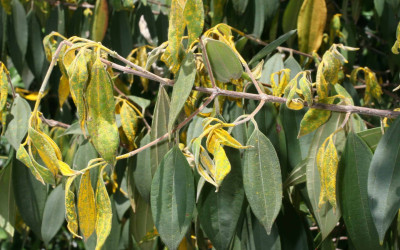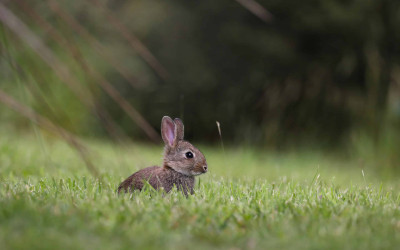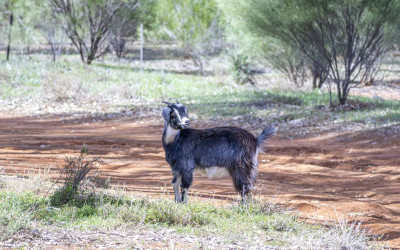MEET THE INVADERS
Cane Toads
Cane toads are stocky, wart-covered amphibians, built for survival.
Behind their heads sit parotoid glands, which release a potent milky toxin when the toad feels threatened.
Females are larger than males. At full size, they can reach 23 cm in length and weigh up to 1.25 kg.
Their appetite is just as impressive as their size. Cane toads will eat almost anything they can fit in their mouths.
They breed rapidly, with males calling from shallow water to attract females. A single female can lay up to 35,000 eggs in one go and may produce two clutches a year.
In their native range in Central and South America, cane toad numbers are kept in check by predators like the rattlesnake.
They are remarkably tough. Cane toads can tolerate a wide range of conditions, surviving temperatures from 5°C to 40°C and even losing up to 50% of their body water without fatal consequences.
Despite their resilience, they still depend on water. They need to rehydrate every day or 2 and stay close to water sources, particularly in drier regions at the edge of their range.
Invasion story
In the early 1930s, Australian scientists were riding a wave of enthusiasm for biological control. The success of the cactus moth in wiping out invasive prickly pear had convinced many that introducing foreign species could solve other environmental problems. So when sugar producers – struggling with poor seasons – needed a quick fix for the destructive native cane beetle, they turned to an unlikely solution: cane toads.
In 1935, 101 toads were imported from Hawaii to the Bureau of Sugar Experiment Stations in north Queensland.
On 19 August 2,400 toadlets were set loose near Little Mulgrave, south-west of Gordonvale, without any research into their potential impact.
The plan seemed simple enough: Bring the toads in, they would feast on cane beetles and crops would be protected.
What could possibly go wrong? Well, as it turns out, pretty much everything.
These toads were a complete flop as pest controllers. Yields of sugar cane in Queensland plantations remained unchanged, and instead of feasting mainly on cane beetles, the toads gobbled up anything that moved – insects, small animals, even pet food left outside.
To make matters worse, Australia proved to be a paradise for them.
These toads were prolific breeders. With no natural predators and an abundance of food, their numbers exploded. Their spread started slowly – about 10 to 15 kilometres per year – but as they moved further inland, the invasion picked up speed.
Starting near Cairns in 1935, it took them 30 years to reach Normanton, Queensland. 22 years later, they arrived at the western edge of the Gulf of Carpentaria. From there, they crossed the Top End in just 18 years, eventually reaching the outskirts of Darwin, from where their pace accelerated to 50 to 60 kilometres per year.
By 2009, they had entered Western Australia and by July 2020, they were already 50 kilometres west of Fitzroy Crossing.
Scientists have dubbed this acceleration the ‘Olympic Village effect’. At the invasion front, only the fastest, most athletic toads push ahead. These super-toads can only breed with others equally fit, favouring genes for speed. Over generations, this has supercharged their ability to disperse, making their hop across the country even more relentless.
Today, cane toads have conquered more than 1.3 million square kilometres of Australia, spreading through Queensland, the Northern Territory, New South Wales and Western Australia. They’ve even turned up as stowaways in places like Sydney.
Experts warn that unless their spread is stopped, they will soon be knocking on Broome’s doorstep, reaching the De Grey River in Western Australia by the mid-to-late 2030s.
How did we get here?
In the rush to defend Australia’s sugar cane industry, science took a backseat to political agendas.
Walter Froggatt, an entomologist, was one of the few voices of caution – warning about the potential disaster the toads could cause. But his concerns were brushed aside.
A ban on further releases of toads, prompted by Froggatt’s warning, was swiftly overturned – directly by the Prime Minister’s office.
Early reports claiming the toads were working in cane fields were based on weak data, but the political pressure to act took precedence over scientific caution. Despite mounting evidence that the toads were useless in cane fields, the Queensland government continued to defend their introduction.
In 2005 the federal government officially recognised cane toads as a key threatening process to the environment.
Fast forward to 2011 and a plan to manage them, called a threat abatement plan, was finally developed.
A senate inquiry into the handling of their spread occurred in 2019. The government stated that over $12 million had been allocated to funding projects aimed at controlling cane toads – though results remain mixed at best.
The toll on nature
Cane toads are killers – not because they hunt, but because they can poison animals that try to eat them.
Cane toads have had devastating impacts on several large, frog-eating native predators.
Australia’s wildlife hasn’t evolved with cane toads, so are highly susceptible to toad toxin.
In some areas, more than 90% of northern quolls, freshwater crocodiles, blue tongue skinks and some goanna species have died soon after toads arrive.
Many northern quoll populations exposed to toads have been wiped out. They’ve become locally extinct from the Mary River region of Kakadu National Park due to toad posioning.
This collapse of top predators can set off a chain reaction as well. Their impact on goannas in some parts of Australia has seen brush turkey populations surge.
Cane toads can also spread parasites and pathogens to native wildlife, adding another layer of pressure on already struggling species.
And we’ve made it easy for them too. They thrive in disturbed landscapes, where land clearing and agriculture provide more water sources, fewer predators and a steady food supply.
There is hope that affected species will eventually recover and coexist with cane toads, either by evolving resistance to toads or learning to avoid them. Red-bellied black snakes in toad-exposed areas in Queensland now avoid eating toads, have smaller heads (reducing their capacity to attack the more-lethal large toads), and are more resistant to toad toxins. Likewise, northern quolls that have survived in a few remnant populations in Queensland avoid attacking cane toads.
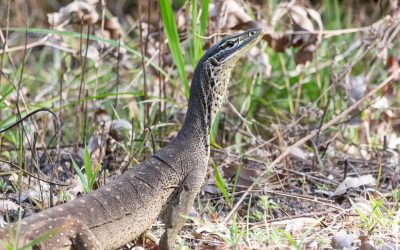
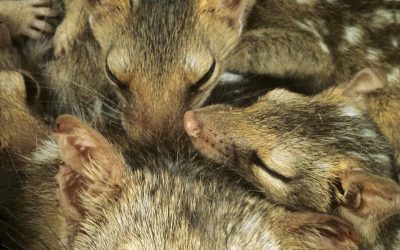
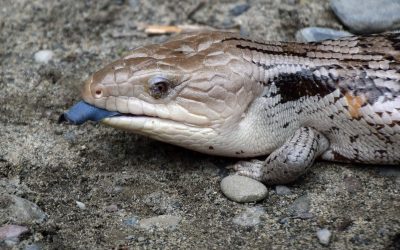
Cultural consequences
For Indigenous communities, cane toads have meant more than just environmental destruction. They’ve contributed to the decline of traditional food sources, like goannas, disrupting cultural practices that have existed for thousands of years.
How do we fix this?
What began as an attempt to control one native species (a pestiferous beetle) has turned into a catastrophe for many other Australian species.
Because cane toads produce so many young, it is impossible to make a dent in their populations simply by killing them one by one.
But thanks to intensive Australian research on cane toads, innovative methods to control or slow the spread of toads have emerged.
The research on cane toad cannibalism has led to the development of a trap that lures toad tadpoles with their own pheromones.
One clever proposal to stop the spread of cane toads down the coast of Western Australia is to create a ‘waterless barrier’ in the Pilbara by stopping the toads from accessing artificial water points such as dams and troughs. They die within a few days if they can’t access water.
Another innovative approach is ‘taste aversion’ – training native predators to steer clear of cane toads by feeding them with a small toad or toad-like bait that makes them nauseous. So far, this has worked for freshwater crocodiles and goannas but not yet for quolls.
Unfortunately, some believe that ‘whacking’ cane toads is a solution, despite research showing this isn’t an effective solution to controlling numbers or spread, except in some isolated outbreaks. In fact, it is common for some native frogs, including threatened species, to be misidentified as cane toads and harmed by mistake.
In an industrial estate in Sydney, a cane toad outbreak was completely wiped out through a mix of hand collection, fencing and tadpole trapping.
There is hope in future that use of pheromones both for trapping and population suppression, will enable the reduction of cane toad impacts.
The Invasive Species Council advocates for stronger research support, better funding, smarter strategies and stronger coordination for the management of invasive species, like cane toads. Notably, our Froggatt Awards, named after Walter Froggatt, celebrate those change makers who go above and beyond in tackling invasive species.
While I was a PhD student researching carnivorous marsupials in the Western Australian Museum in Perth, a colleague from the Royal Perth Hospital asked me if I’d like to see if it would be possible to raise a baby Western Quoll (Dasyurus geoffroii) as a pet. I excitedly agreed and over the next years that Quoll and I became the best and closest of friends. But one night after I moved to Queensland, while he was running around the ground floor, he found and bit a Cane Toad (Rhinella marina), holding it in his mouth for perhaps 15 seconds, then dropped it. He began to paw at his mouth, holding it open, clearly distressed. I washed out his mouth but he rapidly became desperately unhappy. His eyes were bulging, his mouth held agape, his breathing frantically rapid, and he seemed completely oblivious to all of my efforts to comfort him. Immediately frightened, I bundled him up and over the next 20 minutes raced him to three different vets in the Gap area of Brisbane but not one of them knew that Cane Toads were poisonous or what I might be able to do to help him. By that time he was convulsing with tetanic contractions and a few moments after the last vet said ‘sorry’ as I stood on his front porch, my wonderful friend died in agony in my arms, on the saddest 28th day of April, 1973. After I overcame my grief but not my anger, I teamed up with the then Curator of Reptiles, the wonderful and sorely missed Jeanette Covacevich, to canvass school kids throughout Queensland via surveys distributed in schools to find out if any of them were aware of any other negative impacts of Cane Toads on native animals, and the responses flooded in: kookaburras found dead with cane toads in their mouths, snakes found dead having ingested Cane Toads, freshwater crocodiles dead with Cane Toads in their stomachs, and on it went. So in 1975 we published in the Memoirs of the Queensland Museum the first paper about this enormous problem that most vets and other animal carers seemed to be unaware of. When I subsequently reported the symptoms my Quoll had exhibited as he was dying to a newspaper reporter, the Royal Brisbane Hospital called me up to say they had checked their records for unexplained deaths of children who had exhibited similar symptoms and found in some reports that parents had found their dying child in the back yard holding a Cane Toad in their hand, but no-one at the time thought Cane Toads were potentially lethal so the connection wasn’t drawn. Although Cane Toads appear to be unstoppable, at least zoologists are now fully aware of the danger and doing everything they can to ‘toad-proof’ the native biota as these disastrous invaders inexorably spread across the whole of the northern half of the continent. Yet, as I think back on the events of 1973, I do so wish that my beloved Western Quoll did not have to be the agonised sacrifice that opened our eyes to this problem.
Professor Mike Archer, Earth and Sustainability Science Research Center School of Biological, Earth & Environmental Sciences UNSW Sydney (University of New South Wales)
FAQs
Cane toads were introduced to Queensland in 1935 with the intention of controlling cane beetles in sugar cane crops. Unfortunately, the toads did not effectively control the beetles and instead became a significant invasive species, causing harm to native wildlife.
Cane toads have several negative impacts on native species, primarily through lethal ingestion of their toxins. This has led to population declines in species such as freshwater crocodiles, snakes, goannas and northern quolls. Cane toads can also compete with native species for resources and shelter. Some native species can recover and coexist with toads by evolving resistance or learning to avoid them.
Currently, the only effective method is to trap the tadpoles in water by luring them with their own pheromones. There are some less effective methods like hand collection (toad busting).
The Australian Government has a leadership and coordination role in national efforts to control cane toads. Effective action requires all levels of government to ensure effective action and coordination, with state and territory governments as key implementing partners. Controlling the spread and impact of cane toads is of national significance, requiring commitment from all affected governments.
Hull, G. (2021). The Ferals that ate Australia. Black Inc.
Shine, R 2010, ‘The ecological impact of invasive cane toads (Bufo marinus) in Australia’, The Quarterly Review of Biology, vol. 85, no. 3, pp. 253–291, The University of Chicago Press. Available at: http://www.jstor.org/stable/10.1086/655116
Shine, R 2015, ‘Unwelcome and unpredictable: the sorry saga of cane toads in Australia’, in S Morton, D Lindenmayer & S Dovers (eds), Austral ark: the state of wildlife in Australia and New Zealand, Cambridge University Press, Cambridge. Available at: https://www.cambridge.org/core/books/abs/austral-ark/unwelcome-and-unpredictable-the-sorry-saga-of-cane-toads-in-australia/3F4603F358A2BEE04FFF04C6F650D877
C Booth, V Adams, B Kruse, L Douglass. The Enduring Pilbara: A conservation vision for a land rich in nature, culture and resources. Centre for Conservation Geography and University of Tasmania, 2021
Parliament of the Commonwealth of Australia 2018, Cane toads on the march: inquiry into controlling the spread of cane toads, House of Representatives Standing Committee on the Environment and Energy, Canberra.
Jolly, CJ, Shine, R & Greenlees, MJ 2015, ‘The impact of invasive cane toads on native wildlife in southern Australia’, Ecology and Evolution, vol. 5, pp. 3879–3894.
Hutchins, C 2015, ‘Keeping toads out of the Pilbara’, Wildlife Australia, vol. 52.
The Wildlife Society. ‘Cane toads aren’t just invasive, they can also be cannibals’, The Wildlife Society.
Indigo, N.L., Kelly, E., Smith, J., Webb, J.K., & Phillips, B.L. (2023). Can conditioned taste aversion be deployed at a landscape level to mitigate the impact of invasive cane toads on northern quolls? Wildlife Research, 50(12), 1046–1057. https://doi.org/10.1071/WR21151
Ward-Fear, G., Bruny, M., Bunuba Rangers, Forward, C., Cooksey, I., & Shine, R. (2024). Taste aversion training can educate free-ranging crocodiles against toxic invaders. Proceedings of the Royal Society B: Biological Sciences, 291, 20232507. https://doi.org/10.1098/rspb.2023.2507
- Hull, G. (2021). The Ferals that ate Australia. Black Inc.
- Shine, R 2010, ‘The ecological impact of invasive cane toads (Bufo marinus) in Australia’, The Quarterly Review of Biology, vol. 85, no. 3, pp. 253–291, The University of Chicago Press. Available at: http://www.jstor.org/stable/10.1086/655116
- Shine, R 2015, ‘Unwelcome and unpredictable: the sorry saga of cane toads in Australia’, in S Morton, D Lindenmayer & S Dovers (eds), Austral ark: the state of wildlife in Australia and New Zealand, Cambridge University Press, Cambridge. Available at: https://www.cambridge.org/core/books/abs/austral-ark/unwelcome-and-unpredictable-the-sorry-saga-of-cane-toads-in-australia/3F4603F358A2BEE04FFF04C6F650D877
- C Booth, V Adams, B Kruse, L Douglass. The Enduring Pilbara: A conservation vision for a land rich in nature, culture and resources. Centre for Conservation Geography and University of Tasmania, 2021
- Parliament of the Commonwealth of Australia 2018, Cane toads on the march: inquiry into controlling the spread of cane toads, House of Representatives Standing Committee on the Environment and Energy, Canberra.
- Jolly, CJ, Shine, R & Greenlees, MJ 2015, ‘The impact of invasive cane toads on native wildlife in southern Australia’, Ecology and Evolution, vol. 5, pp. 3879–3894.
- Hutchins, C 2015, ‘Keeping toads out of the Pilbara’, Wildlife Australia, vol. 52.
- The Wildlife Society. ‘Cane toads aren’t just invasive, they can also be cannibals’, The Wildlife Society.
- Indigo, N.L., Kelly, E., Smith, J., Webb, J.K., & Phillips, B.L. (2023). Can conditioned taste aversion be deployed at a landscape level to mitigate the impact of invasive cane toads on northern quolls? Wildlife Research, 50(12), 1046–1057. https://doi.org/10.1071/WR21151
- Ward-Fear, G., Bruny, M., Bunuba Rangers, Forward, C., Cooksey, I., & Shine, R. (2024). Taste aversion training can educate free-ranging crocodiles against toxic invaders. Proceedings of the Royal Society B: Biological Sciences, 291, 20232507. https://doi.org/10.1098/rspb.2023.2507






